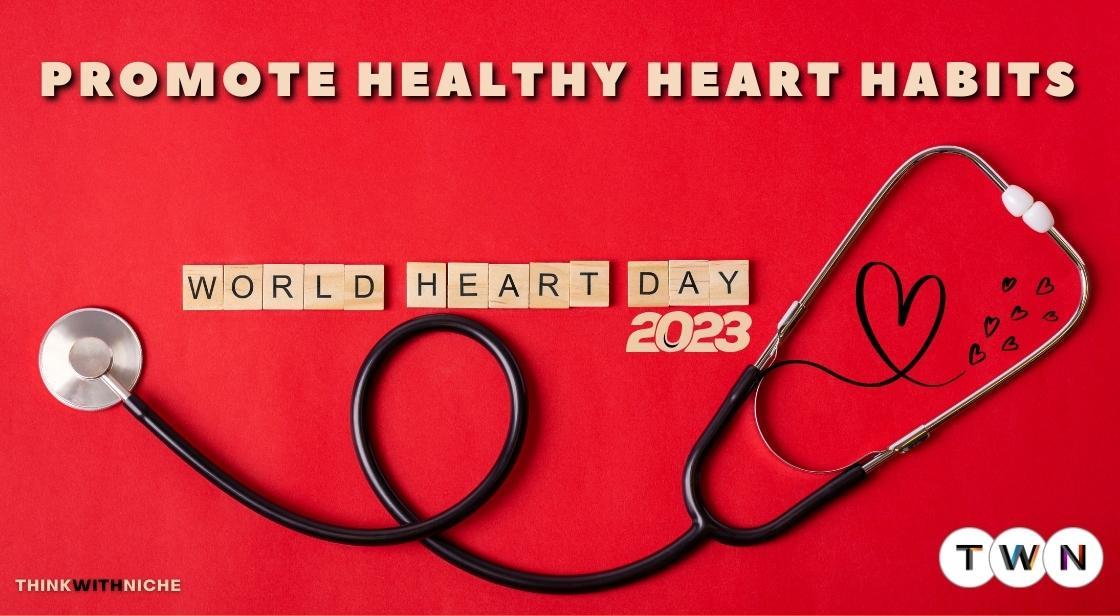World Heart Day 2023: Promote Healthy Heart Habits

Blog Post
World Heart Day, observed annually on September 29, transcends a simple celebration, evolving into a global initiative with a pivotal mission.
This significant day is dedicated to raising awareness about the pervasive threat of cardiovascular diseases (CVD), encompassing heart disease and stroke, which collectively claims 17.9 million lives each year.
More than a commemoration, World Heart Day serves as a call to action, urging individuals, healthcare professionals, organizations, and governments to unite in the fight against this silent global epidemic.
As we delve into the reasons behind celebrating World Heart Day, we uncover its broader implications in fostering understanding, encouraging preventive measures, and driving positive change for heart health on a global scale.
On World Heart Day 2023, let's delve into the latest data and facts surrounding heart health to raise awareness about the importance of fostering healthy habits for a strong and resilient heart.
World Heart Day, observed annually on September 29, serves as a global platform to highlight cardiovascular health issues and promote heart-healthy habits. As we mark this day in 2023, the significance of prioritizing heart health is more critical than ever.
Let's explore the latest data and evidence-based practices to encourage everyone to adopt lifestyle choices that contribute to a healthy heart.
World Heart Day 2023: Promote Healthy Heart Habits
World Heart Day 2023 Theme:
'Use Heart, Know Heart': The heartbeat of World Heart Day 2023 resonates with the powerful theme, 'Use Heart, Know Heart.' This encapsulates a multifaceted approach, urging individuals and organizations to embrace a holistic perspective on heart health. The theme invites participants to delve into the intricacies of cardiovascular well-being, emphasizing both understanding the heart and actively utilizing this knowledge.
Flexibility in Focus:
What sets World Heart Day apart is its flexibility. Unlike rigidly adhering to a predefined theme, the campaign allows for customization based on the diverse interests and concerns of those championing the cause. Whether it's the environmental impact on heart health, accessibility to healthcare, mental well-being, or specific risk factors, participants can choose their focus areas to engage and provoke their audiences.
Empowering Campaign Activators:
The World Heart Federation empowers campaign activators by entrusting them with the freedom to select their area of concentration. This approach ensures that the campaign's impact is tailored to the unique needs and concerns of different communities. By posing relevant and thought-provoking questions, the campaign sparks conversations that resonate with diverse audiences.
Beyond Traditional Boundaries:
The open-ended nature of World Heart Day's thematic approach extends beyond conventional boundaries. It mirrors the dynamic nature of global health challenges, acknowledging that heart health is intricately linked with various aspects of our lives. This flexibility encourages a comprehensive exploration of issues surrounding cardiovascular health.
Global Relevance of the Theme: 'Use Heart, Know Heart' is not confined by geographic or cultural boundaries. It speaks to a universal audience, transcending language and location. The theme prompts a collective reflection on the importance of actively utilizing our understanding of heart health, fostering a sense of responsibility and empowerment among individuals and communities worldwide.
Encouraging Thought Leadership:
By providing the freedom to choose focus areas, World Heart Day cultivates thought leadership. Activators become catalysts for change in their respective spheres, initiating discussions, and promoting initiatives that align with the unique health challenges faced by their communities.
Evolution of World Heart Day: A Journey of Health Advocacy"
The origins of World Heart Day can be traced back to the collaborative efforts of the World Heart Federation and the World Health Organization in 1999. The inception of this global observance, conceived by the former president of the World Heart Federation, Antoni Baye de Luna, marked a significant milestone in advocating for cardiovascular health on a worldwide scale.
Early Years: World Heart Day made its debut in 1999, emerging as a testament to the growing recognition of the escalating challenges posed by cardiovascular diseases. Antoni Baye de Luna's vision laid the foundation for an annual event dedicated to raising awareness about heart health, prevention, and the impact of cardiovascular diseases on a global scale.
Change in Observance Date:
In its early years, from 1999 to 2011, World Heart Day was traditionally observed on the last Sunday of September. This choice of date reflected a commitment to creating a collective global moment to focus on heart health.
Global Commitment in 2012:
The significant shift in the observance date came in 2012, catalyzed by a pivotal global commitment. World leaders, recognizing the urgent need to address non-communicable diseases, pledged to reduce global mortality from such diseases by 25 percent by the year 2025. This commitment reshaped the landscape of World Heart Day, transforming it into an annual event observed on the fixed date of 29th September.
The 29th September Tradition:
Since 2012, World Heart Day has been consistently observed on 29th September each year. This fixed date serves as a unifying factor, aligning with the global commitment made by leaders to tackle the rising challenges of cardiovascular diseases.
Evolution as a Global Health Advocacy Day:
Beyond its historical roots, World Heart Day has evolved into a dynamic platform for global health advocacy. It transcends traditional observances and has become a day for fostering awareness, promoting preventive measures, and catalyzing actionable initiatives to combat cardiovascular diseases.
Continued Relevance:
As we reflect on the history of World Heart Day, its continued relevance becomes evident. The day stands as a symbol of the ongoing struggle against cardiovascular diseases and the collective determination to build a healthier world. Antoni Baye de Luna's visionary concept has flourished into an annual occasion that unites people, organizations, and nations in the pursuit of heart health.
Global Cardiovascular Health Landscape
Cardiovascular disease (CVD) is the leading cause of death globally, claiming over 18 million lives each year. It is estimated that by 2030, CVD will account for 23.3 million deaths worldwide.
The burden of CVD is heaviest in low- and middle-income countries (LMICs), where it accounts for over 80% of all CVD deaths. This is due to a number of factors, including:
-
High rates of risk factors: LMICs have high rates of risk factors for CVD, such as unhealthy diet, physical inactivity, smoking, and diabetes.
-
Limited access to healthcare: Many people in LMICs do not have access to the healthcare they need to prevent and manage CVD.
Despite the high burden of CVD in LMICs, there has been some progress in recent years. For example, the prevalence of smoking has declined in many LMICs, and there has been an increase in awareness of CVD risk factors.
However, more needs to be done to reduce the burden of CVD in LMICs.
Here are some of the latest findings on the global cardiovascular health landscape:
-
CVD is on the rise in young people: A study published in the Journal of the American Heart Association found that the rate of CVD in young people (aged 18-39) has increased by 38% over the past 20 years. This is likely due to a number of factors, including the increasing prevalence of risk factors such as obesity and diabetes.
-
Social determinants of health play a major role in CVD: A study published in the Lancet found that social determinants of health, such as poverty, education, and access to healthcare, are major contributors to CVD risk. This suggests that addressing social determinants of health is essential to reducing the burden of CVD.
-
Digital health technologies have the potential to improve cardiovascular health: Digital health technologies, such as wearable devices and mobile apps, can be used to track health data, provide personalized feedback, and support behavior change. A study published in the European Heart Journal found that digital health technologies can be effective in improving cardiovascular health outcomes.
The global cardiovascular health landscape is complex and challenging. However, there is hope. By understanding the latest information on CVD risk factors and prevention strategies, we can work to reduce the burden of CVD worldwide.
Also Read: Coffee- How Does It Affect Blood Pressure?
Global Awareness Initiatives
There are a number of global awareness initiatives that are working to raise awareness of CVD and promote healthy heart habits. These include:
-
World Heart Day: World Heart Day is celebrated on September 29th each year to raise awareness of CVD and promote healthy heart habits.
-
Hearts for Hearts: Hearts for Hearts is a global campaign that brings together people from all over the world to raise awareness of CVD and promote healthy heart habits.
-
Hearts of Gold: Hearts of Gold is a global initiative that supports women in developing countries to prevent and manage CVD.
These initiatives are playing an important role in raising awareness of CVD and promoting healthy heart habits around the world. By working together, we can reduce the burden of CVD and improve the health of people everywhere.
Key Statistics and Data on Cardiovascular Health
-
Global prevalence of CVD: CVD is the leading cause of death worldwide, accounting for over 18 million deaths each year.
-
Prevalence of CVD by region: The burden of CVD is heaviest in low- and middle-income countries (LMICs), where it accounts for over 80% of all CVD deaths.
-
Risk factors for CVD: The main risk factors for CVD include unhealthy diet, physical inactivity, smoking, and diabetes.
-
Mortality rates from CVD: The mortality rate from CVD varies by region, but it is high in all regions. In LMICs, the mortality rate from CVD is more than double the mortality rate in high-income countries.
Latest Statistics
Here are some of the latest statistics on heart diseases, risk factors, and mortality rates:
-
Cardiac arrest: Cardiac arrest is a sudden loss of heart function. It is the leading cause of death outside of hospitals. In the United States, over 350,000 people die from cardiac arrest each year.
-
Stroke: Stroke is a leading cause of disability and death. In the United States, over 795,000 people have a stroke each year, and nearly 140,000 people die from stroke each year.
-
High blood pressure: High blood pressure is the leading risk factor for CVD. Over 1.28 billion people worldwide have high blood pressure.
-
High cholesterol: High cholesterol is another major risk factor for CVD. Over 415 million people worldwide have high cholesterol.
-
Obesity: Obesity is a major risk factor for CVD and other chronic diseases. Over 650 million adults worldwide are obese.
-
Diabetes: Diabetes is a major risk factor for CVD and other chronic diseases. Over 463 million adults worldwide have diabetes.
Mortality Rates
The mortality rates from CVD vary by region, but they are high in all regions. In LMICs, the mortality rate from CVD is more than double the mortality rate in high-income countries.
-
Mortality rate from CVD in LMICs: 325 deaths per 100,000 people
-
Mortality rate from CVD in high-income countries: 150 deaths per 100,000 people
What Can Be Done?
There are a number of things that can be done to reduce the burden of CVD worldwide. These include:
-
Promoting healthy lifestyles: This includes eating a healthy diet, being physically active, and not smoking.
-
Addressing social determinants of health: This includes addressing poverty, education, and access to healthcare.
-
Developing and implementing effective prevention programs: These programs should target the major risk factors for CVD, such as high blood pressure, high cholesterol, obesity, and diabetes.
-
Improving access to healthcare: This is especially important in LMICs, where many people do not have access to the healthcare they need to prevent and manage CVD.
By working together, we can reduce the burden of CVD and improve the health of people everywhere.
The Impact of Lifestyle Choices
Diet
What you eat has a significant impact on your heart health. Eating a healthy diet can help to reduce your risk of developing CVD, stroke, and other heart-related diseases.
Latest Research Findings
A study published in the Journal of the American Heart Association found that people who followed a Mediterranean diet had a lower risk of developing CVD than people who followed a standard diet. The Mediterranean diet is rich in fruits, vegetables, whole grains, legumes, nuts, and seeds, and it is low in saturated and trans fats.
Another study, published in the European Heart Journal, found that people who lost weight and followed a healthy diet were able to significantly improve their blood pressure, cholesterol levels, and blood sugar levels. This can help to reduce the risk of developing CVD.
Mediterranean diet plate, with fruits, vegetables, whole grains, legumes, nuts, and seeds
Physical Activity
Regular physical activity is another important factor in heart health. Exercise helps to strengthen the heart and improve circulation.
Latest Research Findings
A study published in the Lancet found that people who were physically active for at least 150 minutes per week had a lower risk of developing CVD than people who were not physically active. The study also found that people who were more physically active had a lower risk of developing stroke and other heart-related diseases.
Another study, published in the Journal of the American Medical Association, found that people who started exercising later in life were still able to reduce their risk of developing CVD. The study found that even people who started exercising in their 60s or 70s were able to reduce their risk of developing CVD by 30%.
Stress Management
Stress can also have a negative impact on heart health. When you are stressed, your body releases hormones that can damage your blood vessels and increase your risk of developing CVD.
Latest Research Findings
A study published in the European Heart Journal found that people who were able to manage their stress had a lower risk of developing CVD than people who were not able to manage their stress. The study also found that stress management can help to improve blood pressure, cholesterol levels, and blood sugar levels.
Another study, published in the Journal of Psychosomatic Research, found that people who practiced meditation had a lower risk of developing CVD than people who did not practice meditation. Meditation is a type of stress management that can help to reduce stress and improve heart health.
Heart-Healthy Diet Recommendations
The following are some evidence-based dietary guidelines to support a healthy heart:
-
Eat plenty of fruits and vegetables. Aim for at least five servings per day.
-
Choose whole grains over refined grains.
-
Include lean protein sources in your diet, such as fish, chicken, beans, and tofu.
-
Limit saturated and trans fats.
-
Choose healthy fats, such as those found in olive oil, avocados, and nuts.
-
Limit processed foods, sugary drinks, and excessive amounts of salt.
Physical Activity and Heart Health
The following are some recommended exercise routines for a strong heart:
-
Aim for at least 150 minutes of moderate-intensity aerobic activity or 75 minutes of vigorous-intensity aerobic activity each week.
-
Include strength training exercises that work all major muscle groups two to three times per week.
-
If you are new to exercise, start slowly and gradually increase the duration and intensity of your workouts over time.
Preventive Measures for Heart Diseases
There are a number of preventive measures that can be taken to reduce the risk of developing heart diseases:
-
Get regular checkups and screenings.
-
Manage your blood pressure, cholesterol, and blood sugar levels.
-
Maintain a healthy weight.
-
Eat a healthy diet and exercise regularly.
-
Do not smoke.
-
Limit alcohol consumption.
As we observe World Heart Day 2023, let's collectively work towards a heart-healthy world by fostering awareness, adopting positive lifestyle changes, and prioritizing cardiovascular well-being.
Cardiovascular Disease: The Silent Killer
CVD is often called the "silent killer" because it often has no symptoms until it is too late. However, there are a number of risk factors for CVD that we can control.
The Risk Factors for CVD
The main risk factors for CVD include:
-
Unhealthy diet: Eating a diet high in saturated and trans fats, cholesterol, and sugar can increase the risk of CVD.
-
Physical inactivity: Regular physical activity helps to lower blood pressure, cholesterol, and blood sugar levels. It also helps to maintain a healthy weight.
-
Smoking: Smoking damages the lining of the blood vessels and increases the risk of blood clots.
-
Excessive alcohol consumption: Drinking too much alcohol can raise blood pressure and triglyceride levels. It can also damage the heart muscle.
Healthy Heart Habits
There are a number of things we can do to reduce our risk of CVD and improve our overall heart health. These include:
-
Eating a healthy diet: Eat plenty of fruits, vegetables, and whole grains. Choose lean protein sources and healthy fats. Limit processed foods, sugary drinks, and unhealthy fats.
-
Being physically active: Aim for at least 150 minutes of moderate-intensity aerobic activity or 75 minutes of vigorous-intensity aerobic activity each week.
-
Quitting smoking: Smoking is the single biggest risk factor for CVD. If you smoke, quitting is the best thing you can do for your heart health.
-
Limiting alcohol consumption: If you drink alcohol, do so in moderation. For men, this means no more than two drinks per day. For women, it means no more than one drink per day.
How to Promote Healthy Heart Habits
There are a number of things we can do to promote healthy heart habits in ourselves and others. These include:
-
Set a good example: Make healthy choices yourself and talk to your family and friends about the importance of heart health.
-
Educate yourself: Learn more about the risk factors for CVD and how to reduce your risk.
-
Support healthy policies: Support policies that promote healthy eating, physical activity, and smoking cessation.
-
Get involved in your community: Volunteer for organizations that are working to improve heart health.
By making healthy lifestyle choices and promoting healthy heart habits, we can all help to reduce the burden of CVD and improve our overall health and well-being.
Understanding the Significance of World Heart Day
World Heart Day is not just a day of celebration; it's a global initiative with a critical mission. The primary goal of observing this day is to increase awareness about cardiovascular diseases (CVD), their prevention, and the profound impact they have on individuals worldwide.
With an annual toll of 17.9 million lives claimed by CVD, which includes heart disease and stroke, the day serves as a poignant reminder of the urgent need to address this health crisis.
Let's delve deeper into the reasons behind celebrating World Heart Day and explore its broader implications.
The Global Health Challenge: CVD, encompassing heart disease and stroke, stands as a formidable global health challenge, claiming a staggering 17.9 million lives each year. This sobering statistic emphasizes the severity of the issue and underscores the imperative to take collective action to mitigate its impact.
Raising Awareness for Prevention: At the heart of World Heart Day is a commitment to raising awareness about CVD prevention. The day serves as a beacon, directing attention to the actions individuals can take to prevent and control CVD. By fostering understanding and disseminating information, World Heart Day empowers people to make informed choices for their cardiovascular health.
The Annual Theme: Every year, World Heart Day is celebrated with a specific theme, addressing different facets of cardiovascular health. These themes are carefully chosen to shed light on key aspects, such as risk factors, lifestyle modifications, and advancements in medical research. The annual theme acts as a focal point, guiding discussions and initiatives around the world.
Expanding the Impact: The significance of World Heart Day extends beyond a mere commemoration. It serves as a catalyst for global efforts to expand the impact of cardiovascular health initiatives. The day encourages collaboration between individuals, healthcare professionals, organizations, and governments to work collectively towards a world with fewer instances of heart disease and stroke.
A Call to Action: More than just a symbolic observance, World Heart Day is a call to action. It urges individuals to be proactive about their heart health, emphasizing the importance of preventive measures and early detection. By prompting conversations and fostering a sense of responsibility, the day aims to inspire tangible steps toward a heart-healthy lifestyle.
Conclusion:
World Heart Day goes beyond the surface-level celebration; it's a rallying cry for global health. It stands as a reminder that the fight against cardiovascular diseases requires collective effort, awareness, and ongoing commitment. As we observe World Heart Day, let's recognize its profound significance in driving positive change for heart health worldwide.
You May Like
EDITOR’S CHOICE












